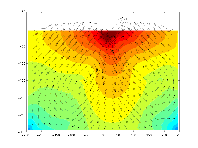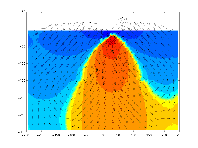 Grid Geometry
Grid GeometryThe GeoFEST (Geophysical Finite Element Simulation Tool) was used to produce this similation of tectonic deformation and stress in response to a generic subduction zone earthquake.
The first figure shows the two-dimensional FE grid, which consists of 6691 nodes and 12,934 displacement degrees of freedom. The continental and oceanic crusts, as well as the downgoing oceanic slab, are described by an elastic rheology. The mantle region in this model is described by a Maxwell viscoelastic rheology with a relaxation time of 50 years. The distances shown are in kilometers.
The second figure is an animation showing both the displacement and shear stress fields of the simulation. The initial frames of the movie show the coseismic increments; the successive frames follow the solution through a total interval of 100 years (two Maxwell times). The "reload" browser function should be used to replay the animation if desired. The third figure shows the same displacement field with the compressive stress superimposed.
Features of interest in the animation are the rotation and relaxation of vector velocities near the surface and at depth during the post-seismic interval. Also note the asymmetric "pulse" or "wave" of shear stress apparent in the crustal channel formed by the hanging wall (continental) plate. Note also that some artifacts of the finite size of the model domain are evident in the form of confined "return flow" mantle circulation patterns.
The development and execution of this model were carried out under the support of NASA Jet Propulsion Laboratory, with contributions by M. Glasscoe, G. Lyzenga, and J. Parker. January 2002.
Click on thumbnail images for full size view.
 Grid Geometry
Grid Geometry
 Displacement and Shear Stress Movie
Displacement and Shear Stress Movie
 Displacement and Compressive Stress Movie
Displacement and Compressive Stress Movie